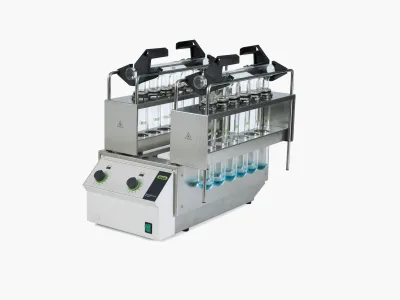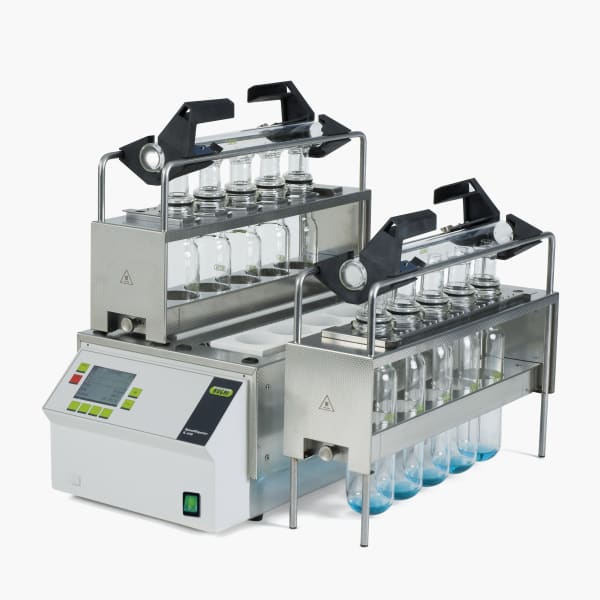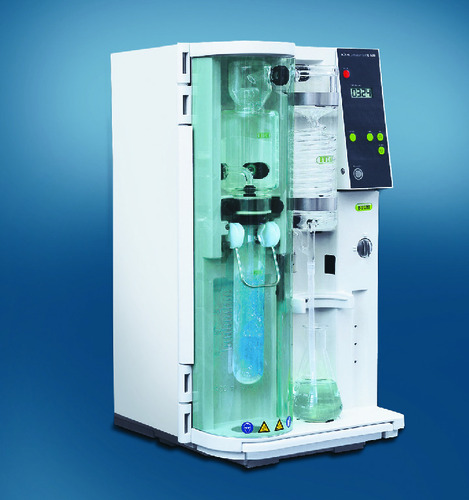Blog Standard

Accurate Determination of Casein Content in Milk Using the Kjeldahl Method
Casein proteins in milk are the predominant class of proteins found in cow milk, accounting for approximately 80% of the total protein content. These proteins are not carried into the whey during processing and are thus integral to the production of cheese and other dairy-based products. Beyond food applications, casein proteins are also widely used in pharmaceuticals, cosmetics, adhesives, paints, and as technical binders.
The determination of casein in milk experiments plays a crucial role in pharmaceutical and food quality control. The analytical technique employed for this purpose must reliably quantify the total nitrogen and differentiate non-casein nitrogen (NCN) fractions to assess the casein content accurately. The Kjeldahl method, recognized for its precision in analysis of nitrogen, remains a gold standard.
This method involves the precipitation of casein using a solution of acetic acid, followed by filtration. The filtrate, which contains non-casein nitrogen, is digested with sulfuric acid and kjeldahl catalyst tablets, converting organic nitrogen to ammonium sulfate. After alkalinization using sodium hydroxide, ammonia is distilled with distillation steam into a boric acid receiver and quantified by boric acid titration using hydrochloric acid. The difference between total nitrogen and non-casein nitrogen provides the casein content, calculated using the appropriate protein factor.
Equipment and Materials
- SpeedDigester K-436/ SpeedDigester K-439
- KjelFlex K-360 for steam distillation
- Schott TitroLine easy for titration
- Scrubber B-414 to absorb acid fumes
- Analytical balance (±0.1 mg precision)
- Connecting cable from Titrator to K-360

Buchi KjelFlex K-360

Buchi SpeedDigester K-439

Buchi KjelFlex K-360
Chemicals:
- 10% Acetic Acid Solution: prepared by diluting 10 ml of acetic acid with deionized water to a final volume of 100 ml.
- 1 M Sodium Acetate Solution: created by dissolving 8.2 g of sodium acetate in deionized water and adjusting the volume to 100 ml.
- Nitrogen-Free Filter Paper 595 ⁄
- Concentrated Sulfuric Acid (98%)
- Catalyst (Mercury and Selenium-Free)
- Stearic acid
- Sodium hydroxide 32 %
- 4% Boric Acid Solution: prepared by dissolving 200 g of boric acid in deionized water and diluting to 5 liters. The solution was then pH-adjusted to 4.65.
- 0.1 M Hydrochloric Acid Standard Solution
- Scrubber Neutralization Solution: consists of 600 g of calcined sodium carbonate, a small amount of ethanol (approx. 2 ml), and a spatula tip of bromothymol blue, all diluted to 3 liters with distilled water.
Samples
- Whole milk UHT (casein content: 2.66%)
- Partial skimmed milk UHT (casein content: 2.71%) Samples were homogenized prior to analysis and sourced from local commercial suppliers.
Procedure
- Sample Homogenization: he milk sample is thoroughly homogenized to ensure uniform distribution of its components.
- Casein Precipitation and Filtration: Casein proteins are selectively precipitated and then separated from the mixture through filtration.
- Filtrate Digestion:The filtered solution undergoes digestion using a SpeedDigester (K-436 or K-439) to break down organic matter and release nitrogen.
- Distillation: The digested sample is then distilled using the KjelFlex K-360 to isolate nitrogen compounds.
- Titration: The distilled product is titrated with a Schott TitroLine easy to quantify nitrogen content accurately.
- Final Calculation: The casein content
is determined using the formula:
Casein = Protein factor × (Total nitrogen − Non-casein nitrogen)
Digestion Method for Casein Analysis in Milk
To accurately measure casein content, the samples undergo a detailed digestion process:
- Sample Preparation: Begin by weighing approximately 20.0 g of milk sample into a 200 ml volumetric flask.
- Protein Precipitation: Add 150 ml of warm water (40°C) and 2 ml of 10% acetic acid. Gently swirl the flask to mix and allow it to stand for 10 minutes to facilitate casein precipitation.
- Buffer Addition: Introduce 2 ml of 1 M sodium acetate solution to the mixture and swirl again to ensure proper blending.
- Dilution and Filtration: Let the mixture cool to room temperature, then top up with water to the 200 ml mark. Filter the solution using nitrogen-free filter paper and collect the entire filtrate.
- Sample Aliquot for Digestion: Transfer 50.0 ml of the filtrate into a 300 ml Kjeldahl digestion tube.
- Add Digestive Agents: To the tube, add 2 Kjeldahl catalyst tablets, 20 ml of concentrated sulfuric acid (98%), a small amount of stearic acid (spatula tip)
- Prepare Blanks: Prepare blank samples (all reagents, no milk sample) for reference and accuracy.
- Pre-Digestion Mixing: Gently swirl the tubes to evenly suspend the contents.
- Fume Absorption Setup: Connect the Scrubber B-414 to the SpeedDigester (K-436 or K-439) to safely absorb acid fumes generated during the digestion.
- Digestion: Insert the rack with all sample tubes into the preheated digestion unit. Digest according to the “NPN/NCN in milk” method parameters (specific to the K-439), or refer to the guidelines listed in Table 1.
Note: For this method, the volumes and sample weights used up to the filtration step have been doubled compared to the official method. This adjustment ensures sufficient filtrate for digestion with both K-436 and K-439 systems. However, the sample-to-reagent ratio remains consistent with the standard protocol.
| K-439 | K-436 | |||
|---|---|---|---|---|
| Step | Temp. [°C] | Time [min] | Level | Time [min] |
| Preheat | 350 | - | 6 | 10 |
| 1 | 550 | 35 | 9.5 | 35 |
| 2 | 490 | 45 | 8.5 | 45 |
| Cooling | - | 30 | - | 30 |
Table 1: Temperature profile for digestion with the K-436, K-439
- If the solution in the sample tube is not clear with a blue-green tint, continue digestion for an additional 30 minutes as outlined in Step 2.
- After digestion, allow the samples to cool to room temperature
Note: Placing the tubes in the designated cooling position will reduce the cooling time to approximately 30 minutes. If left inside the heating chamber, cooling can take 60 minutes or more.
Distillation and Titration
Distill the samples according to the parameters outlined in Table 2 using the KjelFlex K-360, which was connected to a Schott TitroLine easy for automated titration and precise nitrogen determination.
| KjelFlex K-360 | Schott TitroLine easy | ||
|---|---|---|---|
| Water | 80 ml | Titration Solution | HCl 0.1 mol/l |
| NaOH | 80 ml | Internal Method | pH fast strong |
| Boric acid 4% | 50 ml | Endpoint | pH 4.6 |
| Reaction Time | 5 s | ||
| Steam Power | 100% | ||
| Dist. Time | 240 s | ||
| Titration Start | 240 s | ||
| Titration Type | Boric Acid | ||
| Stirrer Sp. Dist. | 5 | ||
| Stirrer Sp. Titr. | 7 | ||
Table 2: Distillation and titration parameters
Calculation of Casein Content
The non-casein nitrogen (NCN) is calculated using titration volume, blank volume, and the sample weight. The total nitrogen and NCN are used in the following equations:
Where
- wNCN : weight fraction of non casein nitrogen [g/g]
- VSample : amount of titrant for the sample [ml]
- VBlank : mean amount of titrant for the blank [ml]
- VFlask : Volume volumetric flask (200 ml)
- z : molar valence factor (1 for HCl, 2 for H2SO4)
- c : titrant concentration [mol/l]
- f : titrant factor (for commercial solutions normally 1.000)
- MN : molecular weight of nitrogen (14.007 g/mol)
- F : Factor for the volume of the precipitate (0.994 for whole milk and 0.998 for skimmed milk). For partial skimmed milk the factor was calculated taking into account the fat content. The factor for partial skimmed milk = 0.995.
- mSample: sample weight [g]
- %N : percentage of weight of nitrogen [%]
- %NCN : percentage of weight of non casein nitrogen [%]
- %Casein : Casein content [%]
- 6.38 : sample-specific protein factor for milk
Results
Digestion with SpeedDigester K-439
Casein determination in milk:
The results of the casein determination in milk are summarized in Tables 4 and 5.
| Whole Milk | Sample Mass (g) | Sample Volume (ml) | % NCN | Casein [%] |
|---|---|---|---|---|
| Sample 1 | 20.3366 | 4.1 | 0.104 | 2.65 |
| Sample 2 | 20.1807 | 4.01 | 0.102 | 2.66 |
| Sample 3 | 20.2356 | 4.02 | 0.102 | 2.66 |
| Sample 4 | 20.2655 | 4.05 | 0.103 | 2.65 |
| Average | - | - | 0.103 | 2.65 |
| RSD [%] | - | - | 0.77 | 0.19 |
Table 4: Results for the determination of casein in whole milk with K-439
The mean blank volume for this sample was 0.298 ml (n = 4).
| Partial Skimmed Milk | Sample Mass (g) | Sample Volume (ml) | % NCN | Casein [%] |
|---|---|---|---|---|
| Sample 1 | 20.1807 | 4.01 | 0.103 | 2.63 |
| Sample 2 | 20.1835 | 3.98 | 0.102 | 2.64 |
| Sample 3 | 20.2192 | 3.96 | 0.101 | 2.64 |
| Sample 4 | 20.2779 | 3.99 | 0.102 | 2.64 |
| Average | - | - | 0.102 | 2.64 |
| RSD [%] | - | - | 0.64 | 0.16 |
Table 5: Results for the determination of casein in partial skimmed milk with K-439
The mean blank volume for this sample was 0.298 ml (n = 4).
Digestion with SpeedDigester K-436
Casein determination in milk:
The results of the casein determination in milk are summarized in Tables 6 and 7
| Whole Milk | Sample Mass (g) | Sample Volume (ml) | % NCN | Casein [%] |
|---|---|---|---|---|
| Sample 1 | 20.3366 | 4.08 | 0.102 | 2.66 |
| Sample 2 | 20.1807 | 4.07 | 0.102 | 2.66 |
| Sample 3 | 20.2356 | 4.09 | 0.103 | 2.66 |
| Sample 4 | 20.2655 | 4.11 | 0.103 | 2.65 |
| Average | - | - | 0.102 | 2.66 |
| RSD [%] | - | - | 0.48 | 0.12 |
Table 6: Results for the determination of casein in whole milk with K-439
The mean blank volume for this sample was 0.363 ml (n = 4).
| Partial Skimmed Milk | Sample Mass (g) | Sample Volume (ml) | % NCN | Casein [%] |
|---|---|---|---|---|
| Sample 1 | 20.1807 | 4.03 | 0.101 | 2.64 |
| Sample 2 | 20.1835 | 4.07 | 0.102 | 2.63 |
| Sample 3 | 20.2192 | 4.04 | 0.101 | 2.64 |
| Sample 4 | 20.2779 | 4.05 | 0.101 | 2.64 |
| Average | - | - | 0.102 | 2.64 |
| RSD [%] | - | - | 0.51 | 0.13 |
Table 7: Results for the determination of casein in partial skimmed milk with K-436
The mean blank volume for this sample was 0.363 ml (n = 4).
Comparison to Official Methods
This application aligns with the VDLUFA VI C30.4 standard, using equivalent ratios of chemicals despite scaled volumes for comparative instrument testing. The choice of catalyst, sample size, and water volumes are optimized for the equipment but do not impact final results.
| Parameter | This Application Note | Standard Method | Notes / Impact |
|---|---|---|---|
| Catalyst | 10 g Tablets containing: - 47.7% K₂SO₄ - 47.7% Na₂SO₄ - 2.8% TiO₂ - 1.8% CuSO₄ |
10 g K₂SO₄ + 0.25 g CuSO₄ | Easy to handle, especially in routine analytics. The choice of catalyst does not influence the result. |
| Water | 80 ml | 150 ml | The K-360 generates steam in a separate vessel; therefore, less water is needed compared to the standard method. |
| Volumes and Weights | All volumes and weights up to the filtration step were doubled to obtain enough filtrate to digest the same sample with the K-436 and K-439. The ratio between sample and chemicals is equal to the official method. | ||
Conclusion
The determination of casein in milk using the Kjeldahl method in combination with SpeedDigester K-436, SpeedDigester K-439, and KjelFlex K-360 provides a highly reliable and reproducible method for protein determination in dairy products. The low relative standard deviation values confirm the method’s precision. Furthermore, the use of boric acid titration, steam distillation, and modern instrumentation ensures accuracy and compliance with official methodologies.
This robust protocol is ideal for routine milk protein analysis in quality control and research laboratories and demonstrates the continued relevance of the Kjeldahl method in modern nitrogen analysis workflows.
Inkarp Instruments is a leading distributor and trusted service partner for Buchi products in India. Committed to innovation and excellence, Inkarp provides cutting-edge scientific instruments and dependable expert support, empowering researchers nationwide
References:
1. VDLUFA VI C30.4
2. Souci Fachmann Kraut, CRC Press, 7th edition, 2008
Operation manual of SpeedDigester K-425 / K-436
Operation manual of SpeedDigester K-439
Operation manual of Scrubber B-414
Operation manual of KjelFlex K-360
Operation manual of TitroLine easy (Schott)

